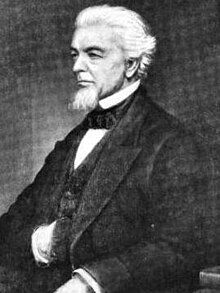| William Wolcott Ellsworth | |
|---|---|
 | |
| 30th Governor of Connecticut | |
| In office May 2, 1838 – May 4, 1842 | |
| Lieutenant | Charles Hawley |
| Preceded by | Henry W. Edwards |
| Succeeded by | Chauncey Fitch Cleveland |
| Member of the U.S. House of Representatives from Connecticut's at-large district | |
| In office March 4, 1829 – July 8, 1834 | |
| Preceded by | David Plant |
| Succeeded by | Joseph Trumbull |
| Personal details | |
| Born | November 10, 1791 Windsor, Connecticut |
| Died | January 15, 1868(1868-01-15) (aged 76) Hartford, Connecticut |
| Political party | Whig Republican |
| Spouse | Emily S. Webster |
| Relations | Oliver Ellsworth (father) Henry Leavitt Ellsworth (brother) Noah Webster (father-in-law) Henry W. Ellsworth (nephew) |
| Children | 6 |
| Alma mater | Yale College, Litchfield Law School |
| Profession | Lawyer, politician, judge |
William Wolcott Ellsworth (November 10, 1791 – January 15, 1868) was a Yale-educated attorney who served as the 30th governor of Connecticut, a three-term United States Congressman, a justice of the State Supreme Court.
Biography

Born in Windsor on November 10, 1791, Ellsworth was the son of Founding Father Oliver Ellsworth, and son-in-law of Noah Webster, who named Ellsworth executor of his will. His twin brother was Henry Leavitt Ellsworth, first Commissioner of the United States Patent Office. He completed preparatory studies, and graduated from Yale College in 1810. He studied law at Tapping Reeve's Litchfield Law School in Litchfield, was afterwards admitted to the bar in 1811.
Among Ellsworth's Yale classmates was Samuel F. B. Morse, whose idea of the telegraph would later be championed by Ellsworth's twin brother Henry Leavitt Ellsworth during his term as the first Commissioner of the U.S. Patent Office.
On September 14, 1813, he was married to Emily S. Webster, eldest daughter of Rebecca Greenleaf and Noah Webster Jr., publisher of dictionaries. Noah Webster named Ellsworth as one of the executors of his will of 1843.
Career

Ellsworth was appointed professor of law at Trinity College in 1827, which position he held until his death. His law partner starting in 1817 was his brother-in-law Chief Justice of the Connecticut Supreme Court Thomas Scott Williams, who was elected to the U.S. Congress that year and sought a younger partner to manage his practice in his absence. (Judge Williams was married to Ellsworth's sister.) Aged 26, Ellsworth took up the reins of Congressman Williams' law practice, the largest in the state.
As an Anti-Jacksonian Ellsworth was elected to the Twenty-first, Twenty-second, and Twenty-third United States Congresses and served from March 4, 1829, to July 8, 1834, when he resigned.
Ellsworth was elected governor of Connecticut 1838–1842. During his tenure, a progressive method for voter registration was constituted and a school commission was founded.
In 1847, Elsworth became judge of the Connecticut Supreme Court and served from 1847 to 1861, when, by the constitutional provision relative to age, he retired. He twice declined to accept the nomination to the United States Senate, and retired from public life.
Death
Ellsworth died in Hartford on January 15, 1868. The former Congressman and Governor is interred at the Old North Cemetery in Hartford.
The lawyer and orator Rufus Choate said of Ellsworth before the Massachusetts General Assembly: "If the land of Shermans, Griswolds, Daggets and Williams, rich as she is in learning and virtue, has a sounder lawyer, a more upright magistrate, or an honester man in her public service, I know not his name."
See also
References
- Litchfield Law School Students, Litchfield Historical Society, litchfieldhistoricalsociety.org
- The Governors of Connecticut, Frederick Calvin Norton, Connecticut Magazine Co., Hartford, 1905
- The inaugural message sent on the new Morse telegraph was dictated by Anna G. Ellsworth, daughter of Ellsworth's twin Henry Leavitt Ellsworth, whose wife suggested the text: "What hath God wrought."
- "William W. Elsworth". Litchfield Historical Society. Retrieved 30 November 2012.
- Chief Justice Williams, Memorials of Connecticut Judges and Attorneys as Printed in the Connecticut Reports, Vol. 29, Pages 611–614, Connecticut State Library, cslib.org Archived 2007-10-19 at the Wayback Machine
- "William W. Ellsworth". Govtrack US Congress. Retrieved 30 November 2012.
- "William W. Ellsworth". National Governors Association. Retrieved 30 November 2012.
- "William W. Ellsworth". The Political Graveyard. Retrieved 30 November 2012.
External links
- United States Congress. "William W. Ellsworth (id: E000150)". Biographical Directory of the United States Congress.
- Litchfield Historical Society
- William W. Ellsworth at Find a Grave
| Party political offices | ||
|---|---|---|
| Preceded byGideon Tomlinson | Whig nominee for Governor of Connecticut 1837, 1838, 1839, 1840, 1841, 1842 |
Succeeded byRoger Sherman Baldwin |
| Political offices | ||
| Preceded byHenry W. Edwards | Governor of Connecticut 1838—1842 |
Succeeded byChauncey Fitch Cleveland |
| U.S. House of Representatives | ||
| Preceded byDavid Plant | Member of the U.S. House of Representatives from Connecticut's at-large congressional district 1829–1834 |
Succeeded byJoseph Trumbull |
- 1791 births
- 1868 deaths
- Governors of Connecticut
- Yale College alumni
- Justices of the Connecticut Supreme Court
- Connecticut Whigs
- Whig Party state governors of the United States
- National Republican Party members of the United States House of Representatives from Connecticut
- Litchfield Law School alumni
- People from Windsor, Connecticut
- 19th-century American judges
- 19th-century members of the United States House of Representatives
